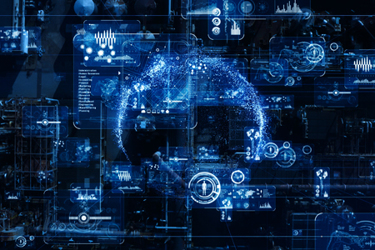Industry 5.0: What It Means For Industry And Water Management
By Bernie Anger

While Industry 4.0 is still very relevant for digital transformation, Industry 5.0 has loftier ambitions — to transform the whole of business and society, sustainably.
The next phase of industrial revolution — Industry 5.0 — is quickly emerging. It evolved from Industry 4.0, which, among other advances, brought together leaps in industrial automation with cloud-type technologies and data analytics to drive productivity. But unlike Industry 4.0 and the three industrial revolutions that preceded it, Industry 5.0 is not driven by the creation of new innovations to revolutionize manufacturing or transform production methods. Instead, it advocates for a monumental shift in priorities — placing societal value and long-term sustainability alongside or ahead of profits.
According to the European Commission, Industry 5.0 provides a vision of industry that aims beyond growth and productivity as the sole goals and reinforces the role and contribution of industry to society and the planet. As a result, industries can play a leading part in addressing our most pressing challenges.
Industry 4.0 profoundly changed manufacturing with the advent of cloud-connected automation. It showed us the power of data, reflected in better process visibility, advances in predictive analytics, and even scenario planning. New concepts such as AI, machine learning, edge computing, the Internet of Things (IoT), and digital twins became part of the industrial vocabulary and tool kit, and when applied to production assets and processes, resulted in operation efficiencies and the ability to gain insights to inform future decision-making.
Industry 5.0 complements this whole paradigm and proposes using those same investments — the same technology and connected ecosystems — to develop solutions to global issues such as climate change and water stress. At its core, Industry 5.0 can be viewed as a call to action and striving for a greater purpose.
Industry 5.0 As A Journey
Industry 5.0 should be viewed as a journey. And different companies are at various stages along this journey. Some have a head start based on greater awareness about the growing importance of environmental stewardship and adopting environmental, social, and governance (ESG) reporting metrics. Many of these organizations have long-standing corporate social responsibility (CSR) programs, which can include measures to conserve water or commitments to using renewable energy. For them, Industry 5.0 provides a catalyst and a framework to accelerate their sustainability performance.
For companies just starting, Industry 5.0 is a building block for developing sustainability-focused initiatives or resource-efficient strategies. One of the first steps they can take is to understand their use of natural resources or their environmental stress points. Carbon footprint is an often-used metric. Companies can also set out to measure the amount of greenhouse gas (GHG) emissions they release or the volume of waste they produce. Determining a water balance and the true cost of water is another. Systematizing these metrics can provide a baseline for setting sustainability performance goals that can be both measured and improved with support from the Industry 4.0 technology tool kit.
Embracing An Industry 5.0 Approach With Water

Whether driven by a CSR commitment or a local water conservation mandate, the demand for efficient water use has never been greater. Moreover, the close link between industrial water usage and energy consumption — and the influence of associated rising costs and carbon footprint — further accentuates the value of implementing Industry 5.0 solutions for water.
One of the ways to get started is through a digitally enabled water balance. Using this approach, a company could evaluate water use across its total footprint and look at every water-related flow — every input and output — at each of its plants. Applying Industry 4.0 technologies in the methodology, such as connected sensors and instruments, digital dashboards, digital twin models, and predictive analytics, will dramatically enhance the accuracy and usability of the calculations.
With a healthy online water balance, plant operators can locate the best opportunities to intervene in the plant to use water more efficiently or develop circular and closed-loop solutions that recycle and reuse process water. Real progress can be made when a plant begins collecting data automatically and combines the data with algorithms to optimize each process, including how each asset operates in terms of saving water. The overall approach starts at a macro level with the water balance and becomes increasingly focused with the help of digital technologies.
The benefit of digital tools is that they generate key insights to make the right set of decisions. And further, they help automate aspects of the work — freeing operators to tackle the next layer of problems. Beginning an Industry 5.0 journey does not always mean that a company will have to invest significant capital in new digital capabilities. In fact, many may already have some of the data and the automation infrastructure for moving ahead. Whether new technologies are required, realizing an ROI is best determined by each company and its situation based on context. But at a minimum, companies are encouraged to embrace a holistic approach when calculating their actual cost of water.
Organizations can maximize their Industry 5.0 implementations by partnering with solutions providers that offer domain expertise and leadership in applying digital technologies. By connecting the different data sources that already exist and complementing them with Industry 4.0 instruments and analytics, companies can identify the best path forward and transform their data into actionable intelligence — enabling them to reach their sustainability goals faster.
About The Author
 As chief digital officer for Veolia Water Technologies & Solutions, Bernie Anger leads the business’s overall digital strategy. His global Digital Enablement team combines an industry-leading portfolio of hardware and cloud-based IOT solutions with domain expertise to deliver powerful customer outcomes through data. Prior to joining Veolia in 2021, Bernie spent his career in corporate environments ranging from entrepreneurial startups to Fortune 50 companies, including GE and its spin-off Abaco Systems, Inc., where he served as CEO.
As chief digital officer for Veolia Water Technologies & Solutions, Bernie Anger leads the business’s overall digital strategy. His global Digital Enablement team combines an industry-leading portfolio of hardware and cloud-based IOT solutions with domain expertise to deliver powerful customer outcomes through data. Prior to joining Veolia in 2021, Bernie spent his career in corporate environments ranging from entrepreneurial startups to Fortune 50 companies, including GE and its spin-off Abaco Systems, Inc., where he served as CEO.
